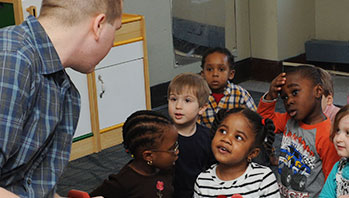- building materials (e.g., toy bricks, bricks, pieces of wood, wooden logs, pieces of cement, large flat rocks, twigs, straw, pieces of metal with rounded edges)
- cardboard boxes and tubes
- plexiglass pieces (available at a hardware store)
- brick
- building
- materials
- twig
MA Standards:
Speaking and Listening: SL.PK.MA.1a Observe and use appropriate ways of interacting in a group (e.g., taking turns in talking, listening to peers, waiting to speak until another person is finished talking, asking questions and waiting for an answer, gaining the floor in appropriate ways).
MA Draft STE Standards:
Physical Sciences/Matter and Its Interactions/PS1.A Describe, compare, sort and classify objects based on observable physical characteristics, uses, and whether it is manufactured as part of their classroom play and investigations of the natural and human-made world.
Head Start Outcomes:
Logic and Reasoning/Reasoning and Problem Solving Classifies, compares, and contrasts objects, events, and experiences.
PreK Learning Guidelines:
English Language Arts/Language 1 Observe and use appropriate ways of interacting in a group (taking turns in talking; listening to peers; waiting until someone is finished; asking questions and waiting for an answer; gaining the floor in appropriate ways).
Mathematics/Patterns and Relations 8 Sort, categorize, or classify objects by more than one attribute.
Talk Together: More Materials

© Commonwealth of Massachusetts, Department of Early Education and Care (Jennifer Waddell photographer). All rights reserved.
STEM Key Concepts: Different materials are used for making different structures and different parts of structures
ELA Focus Skills: Comparing and Contrasting, Listening and Speaking, Observing, Vocabulary
Review the building materials with children. Have children share what they learned about the materials. Ask children what materials they think their house is made of then ask,
- What do you think would happen if your house was made out of sticks, or twigs?
- Why do you think your tall apartment building is made out of bricks?
Take It Further: You may want to graph the materials children’s homes are made of. Make a four-column graph labeled “Brick,” “Wood,” “Stone,” and “Other.” Have children write their name (or tape a name card) on the chart in the correct column. Allow time for children to discuss the graph.
Educator Tip: At this time you may want to introduce the different meanings of the word building. Explain to children that the noun building is a structure like the school/house building you are in now. Then introduce the verb building by acting out building a block tower and say, I am building a block tower. The word building here is an action word—a word that shows I am doing something. You may want to hold up a picture of a building in construction and ask children what the picture shows. Say, The construction people are building a building!
